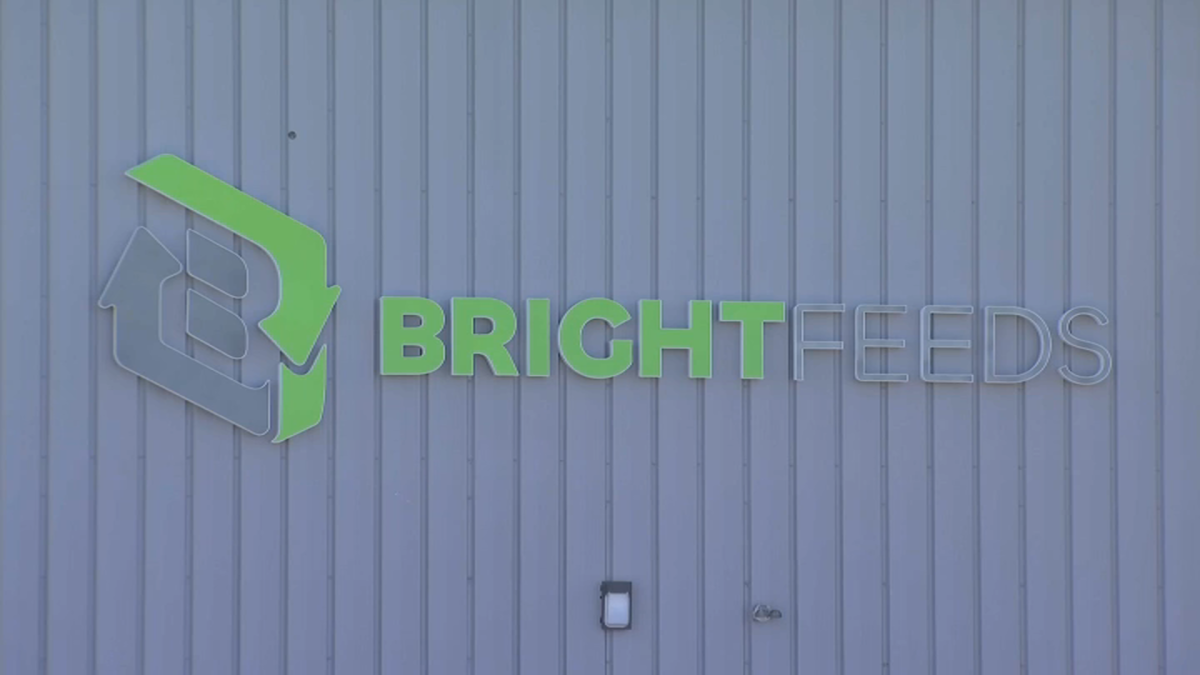Berlin residents upset with ‘overwhelming’ smell from nearby food waste recycling facility
Berlin residents upset with ‘overwhelming' smell from nearby food waste recycling facility NBC Connecticut


Unpleasant Odor from Bright Feeds Facility Raises Concerns in Berlin

Residents and businesses in Berlin, Connecticut are facing an unpleasant odor that has become a cause of unhappiness in the community. Tasca Ford General Manager, Tom Moran, describes the smell as “almost like a rancid meat smell when it happens and the odor permeates.”
Origin of the Odor
According to residents, the smell is emanating from the nearby Bright Feeds food waste recycling facility, which began operations in 2023. The facility’s main objective is to convert food waste materials into renewable natural gas, which is then used as a fuel source to produce animal feed.
Impact on the Community
The odor has had a significant impact on the daily lives of residents and businesses in the area. Lee Chiodo, a resident of Berlin, recalls the pungent smell and expresses his dissatisfaction. Shawn McLaughlin, a representative from Tasca Ford, explains how the smell affects their ability to enjoy outdoor activities and serve customers. He states, “We can’t even come out here and enjoy a nice day like this to go for a walk or enjoy your lunch or something. You can’t be out here. The smell’s horrendous.”
Furthermore, the noise generated by the facility has also been a cause for concern among residents.
Call for Action
Tasca Ford, along with over 100 other signatures, has initiated a petition urging officials to address the issue. The petition highlights the need for immediate action to mitigate the odor and noise problems caused by the Bright Feeds facility.
Response from Bright Feeds
In response to the concerns raised, Bright Feeds released a statement stating that they have taken measures to reduce their sound impact to zero. They also mention that they have received positive evaluations from the Connecticut Department of Energy and Environmental Protection (DEEP) and other authorities. However, they acknowledge the new concerns and assure that they are currently reviewing their processes to address them.
Residents’ Efforts
Tom Moran reveals that the unpleasant odor occurs two or three times a week and becomes overpowering. Shawn McLaughlin has taken the initiative to contact both the town and state authorities in an attempt to find a solution. However, he was informed that the facility operates legally and there is limited action that can be taken.
Sustainable Development Goals (SDGs)
- Goal 11: Sustainable Cities and Communities – The odor issue in Berlin highlights the importance of creating sustainable and livable cities where residents can enjoy a high quality of life without being affected by environmental problems.
- Goal 12: Responsible Consumption and Production – The Bright Feeds facility’s mission aligns with this goal by converting food waste into renewable natural gas, promoting sustainable production practices.
- Goal 13: Climate Action – The use of renewable natural gas as a fuel source contributes to reducing greenhouse gas emissions and combating climate change.
- Goal 15: Life on Land – The facility’s aim to produce animal feed from renewable natural gas supports the preservation of terrestrial ecosystems and biodiversity.
SDGs, Targets, and Indicators
| SDGs | Targets | Indicators |
|---|---|---|
| SDG 3: Good Health and Well-Being | 3.9: By 2030, substantially reduce the number of deaths and illnesses from hazardous chemicals and air, water, and soil pollution and contamination. | – Number of complaints or reports related to health issues caused by the odor or pollution from the Bright Feeds facility. – Number of illnesses or health conditions linked to exposure to the facility’s emissions. |
| SDG 11: Sustainable Cities and Communities | 11.6: By 2030, reduce the adverse per capita environmental impact of cities, including by paying special attention to air quality and municipal and other waste management. | – Air quality measurements in the vicinity of the Bright Feeds facility. – Amount of waste generated by the facility and its impact on the environment. |
| SDG 12: Responsible Consumption and Production | 12.4: By 2020, achieve the environmentally sound management of chemicals and all wastes throughout their life cycle, in accordance with agreed international frameworks, and significantly reduce their release to air, water, and soil in order to minimize their adverse impacts on human health and the environment. | – Compliance with waste management regulations and standards by the Bright Feeds facility. – Efforts made by the facility to minimize the release of pollutants into the air, water, and soil. |
1. Which SDGs are addressed or connected to the issues highlighted in the article?
SDG 3: Good Health and Well-Being
This SDG is connected to the issues highlighted in the article because the unpleasant odor and pollution caused by the Bright Feeds food waste recycling facility can have negative impacts on the health and well-being of the residents and businesses in the area.
SDG 11: Sustainable Cities and Communities
This SDG is addressed in the article as the odor and noise pollution from the Bright Feeds facility affect the quality of life in the community, highlighting the need for sustainable and environmentally friendly practices in urban areas.
SDG 12: Responsible Consumption and Production
This SDG is connected to the article as it emphasizes the importance of managing waste and minimizing its adverse impacts on human health and the environment. The issues raised in the article regarding the odor and pollution from the Bright Feeds facility relate to responsible consumption and production practices.
2. What specific targets under those SDGs can be identified based on the article’s content?
Target 3.9: By 2030, substantially reduce the number of deaths and illnesses from hazardous chemicals and air, water, and soil pollution and contamination.
The article highlights complaints about health issues caused by the odor and pollution from the Bright Feeds facility. This target is relevant as it aims to reduce the negative health impacts of pollution.
Target 11.6: By 2030, reduce the adverse per capita environmental impact of cities, including by paying special attention to air quality and municipal and other waste management.
The article mentions the adverse impact of the facility’s emissions on air quality in the community. This target focuses on reducing the environmental impact of cities, including air quality and waste management.
Target 12.4: By 2020, achieve the environmentally sound management of chemicals and all wastes throughout their life cycle, in accordance with agreed international frameworks, and significantly reduce their release to air, water, and soil in order to minimize their adverse impacts on human health and the environment.
The article raises concerns about the waste management practices of the Bright Feeds facility and its impact on the environment. This target emphasizes the need for environmentally sound management of chemicals and wastes to minimize adverse impacts.
3. Are there any indicators mentioned or implied in the article that can be used to measure progress towards the identified targets?
The article does not explicitly mention specific indicators to measure progress towards the identified targets. However, potential indicators can be inferred based on the information provided:
– Number of complaints or reports related to health issues caused by the odor or pollution from the Bright Feeds facility: This indicator can measure progress towards Target 3.9 by tracking the reduction in the number of complaints or reports over time.
– Air quality measurements in the vicinity of the Bright Feeds facility: Monitoring air quality can serve as an indicator for Target 11.6, as improvements in air quality would indicate progress in reducing the adverse environmental impact.
– Compliance with waste management regulations and standards by the Bright Feeds facility: This indicator can assess progress towards Target 12.4 by evaluating the facility’s adherence to regulations and standards for waste management.
– Efforts made by the facility to minimize the release of pollutants into the air, water, and soil: Monitoring the facility’s efforts to minimize pollution can serve as an indicator for Target 12.4, as it demonstrates progress in achieving environmentally sound management of chemicals and wastes.
Overall, while specific indicators are not explicitly mentioned in the article, these potential indicators can be used to measure progress towards the identified targets.
4. SDGs, Targets, and Indicators
| SDGs | Targets | Indicators |
|---|---|---|
| SDG 3: Good Health and Well-Being | 3.9: By 2030, substantially reduce the number of deaths and illnesses from hazardous chemicals and air, water, and soil pollution and contamination. | – Number of complaints or reports related to health issues caused by the odor or pollution from the Bright Feeds facility. – Number of illnesses or health conditions linked to exposure to the facility’s emissions. |
| SDG 11: Sustainable Cities and Communities | 11.6: By 2030, reduce the adverse per capita environmental impact of cities, including by paying special attention to air quality and municipal and other waste management. | – Air quality measurements in the vicinity of the Bright Feeds facility. – Amount of waste generated by the facility and its impact on the environment. |
| SDG 12: Responsible Consumption and Production | 12.4: By 2020, achieve the environmentally sound management of chemicals and all wastes throughout their life cycle, in accordance with agreed international frameworks, and significantly reduce their release to air, water, and soil in order to minimize their adverse impacts on human health
Copyright: Dive into this article, curated with care by SDG Investors Inc. Our advanced AI technology searches through vast amounts of data to spotlight how we are all moving forward with the Sustainable Development Goals. While we own the rights to this content, we invite you to share it to help spread knowledge and spark action on the SDGs. Fuente: nbcconnecticut.com
Join us, as fellow seekers of change, on a transformative journey at https://sdgtalks.ai/welcome, where you can become a member and actively contribute to shaping a brighter future.
|








